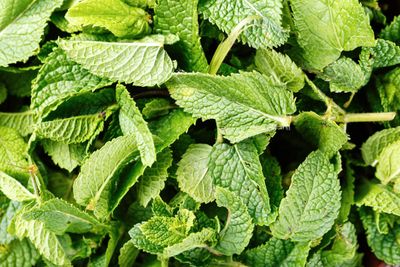What is Mint Mulch?
Mint hay compost is a byproduct of the peppermint and spearmint oil industry. The most common method for commercially extracting the essential oils from mint is by steam distillation. This process starts with the fall harvest of mint plants. Commercial mint crops are harvested in much the same way as grass and legume hay, hence the name mint hay. Mature plants are cut by machine and allowed to air dry in the fields for several days. After drying, mint hay is chopped and taken to a distillery. At the distillery, the chopped mint hay is steam distilled to a temperature of 212 F. (100 C.) for ninety minutes. The steam vaporizes the essential oils. This steam mixture is sent to a condenser to cool and return to a liquid state. As it does, the essential oils separate from the water molecules (Oils float on water.). The next step is to send the liquid to a separator. The steamed plant material which is leftover from the distillation process is called the mint hay compost. Like most compost, it’s dark brownish black in color and rich in organic materials.
Benefits of Using Mint Compost
Landscapers, home gardeners, commercial vegetable producers and fruit and nut orchards have embraced using mint as mulch. Here are a few reasons why it has become popular:
Mint hay compost is 100% natural. It adds organic material to growing beds and can be used for soil amendment. Mint compost has a pH of 6.8.
As a byproduct, using mint compost promotes sustainable agriculture.
Using mint as mulch improves water retention in soil and reduces the need for irrigation.
It contains natural humus, which improves both sandy and clay soils.
Mint compost is a good source of natural nutrients. It’s high in nitrogen and contains phosphorus and potassium, the three main nutrients found in commercial fertilizer.
It contains micronutrients that may be missing in animal manure compost.
Mulching keeps soil temperatures warm and helps control weeds.
Mint can act as a deterrent to mice, rats, and insects.
The distillation process sanitizes mint compost, killing weed seeds and plant pathogens, including viruses and fungi.
Using mint compost is similar to other types of organic mulching products. Spread evenly to a depth of 3 to 4 inches (7.6 to 10 cm.) in weeded beds around plants and at the base of trees.
